Focusing on the transnational network of labour organizations, this book maps change across organizational and relational dimensions. By using two touchstone indicators - the extent of cross-border integration, and the degree of autonomy vis-a-vis the state - it explores the ways in which organized labour has globalized since 1945. The author argues that while the network is more integrated than ever, it remains fixated with state-mediated forms of governance. This is in spite of the many indicators suggesting that organized labour may be disengaging from the state. Al this makes the process of labour globalization a counterintuitive one: organized labour's globalization includes a continuing orientation towards the state. The author's sanguine view of future transnational labour affairs is premised on a likely marriage between oppositional and labour actors at the intersection of regional and bilateral trade negotiations. This book helps to redress an imbalance in the literature that favours structure-focused globalization analyses. It is distinctive because it maintains that globalization can be understood as much as a set of practices as an inexorable structural determinant.

